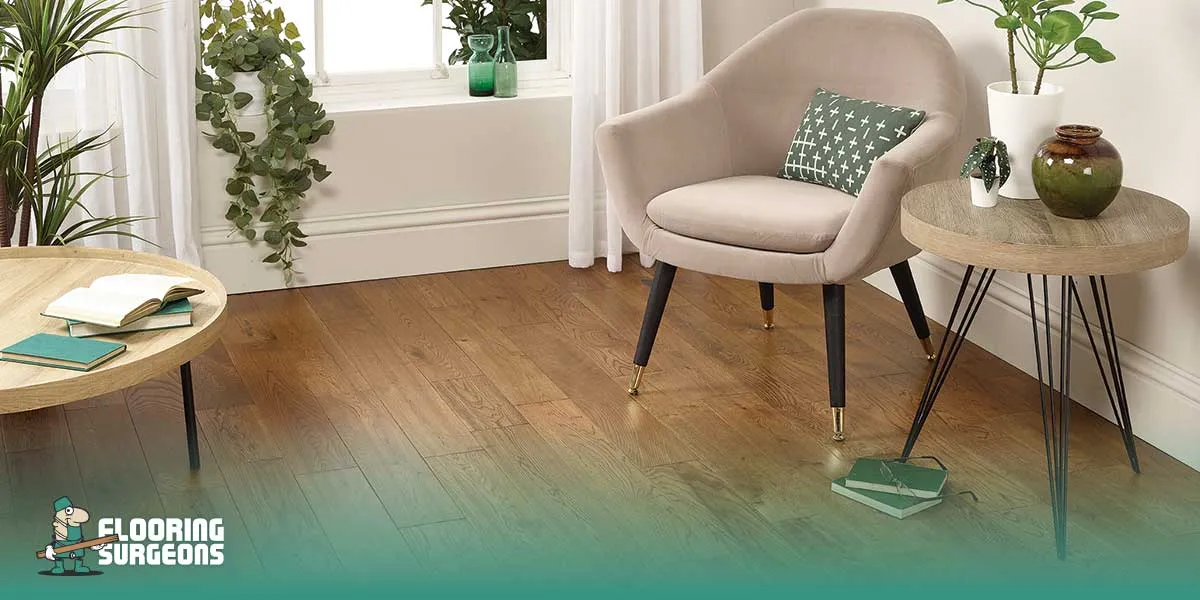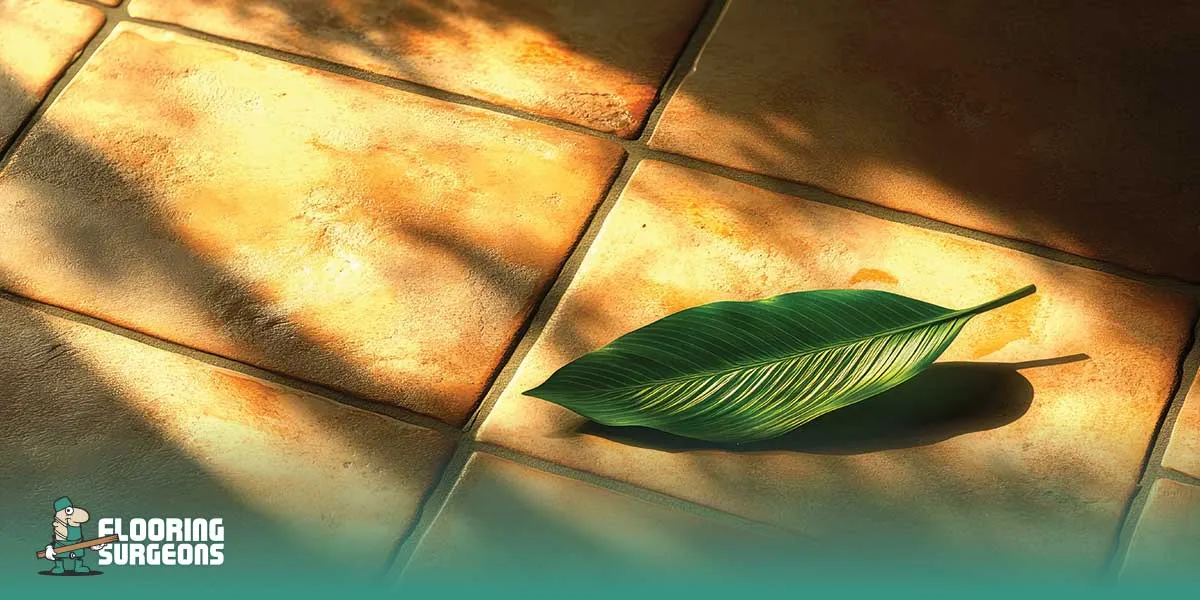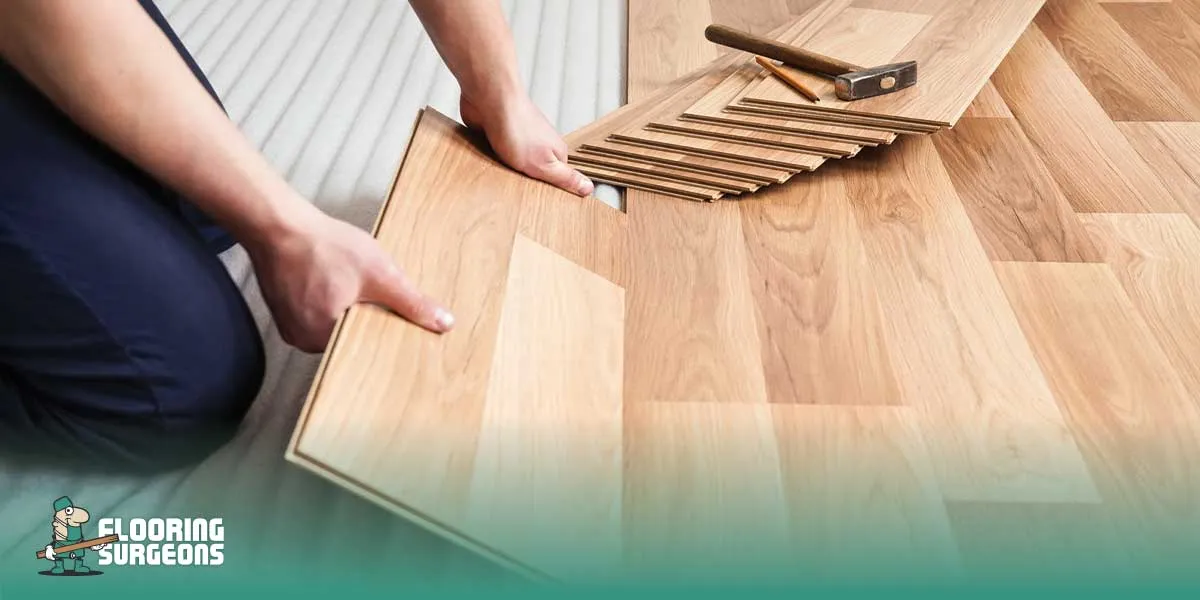Cleaning engineered wood floors is simple all you really need is a soft microfiber mop, a pH-neutral cleaner, and a few smart habits. Start by sweeping away dust daily, then once a week, use a lightly damp mop (never soaking wet) to remove grime without damaging the protective surface. Avoid steam mops and harsh chemicals they can dull the finish and loosen layers over time.
But here’s the thing, most people don’t realise: the real secret to spotless, long-lasting engineered flooring isn’t just how you clean it, but when and with what. In this guide, we’ll show you professional-approved methods to keep your floors gleaming for years from daily care to deep cleaning, polishing, and even removing scratches so your engineered wood floors stay as beautiful as the day they were installed. If you’ve ever wondered “how do I clean engineered wood floors” the right way, this is where you’ll find the answer.
Understanding Engineered Wood Flooring Before You Clean It
Before cleaning engineered wood floors, it’s important to know what makes them unique. Unlike solid hardwood, engineered wood flooring is built from several layers a real hardwood veneer on top and plywood or fibreboard beneath giving it strength, stability, and resistance to warping in changing climates.
That top layer of real wood is what makes your floor beautiful, but also delicate. How you clean it depends on the finish:
- Lacquered floors are sealed and easy to wipe but sensitive to abrasives.
- Oiled floors absorb moisture and need occasional re-oiling to stay fresh.
- Brushed or matte finishes hide dust but can trap dirt without regular dry cleaning.
Avoid soaking the floor or using harsh chemicals even steam can cause swelling or bubbling. Instead, choose a pH-neutral cleaner and a microfiber mop, and use specialised products made for engineered wood to keep it looking new.
At Flooring Surgeons, you’ll find premium cleaning and maintenance solutions designed to protect and enhance your floor’s natural beauty.
Knowing how your floor is made is the secret to keeping it clean, durable, and effortlessly stunning for years to come. So, how do you clean engineered wood floors? The right approach makes all the difference in preserving their natural charm and extending their lifespan.
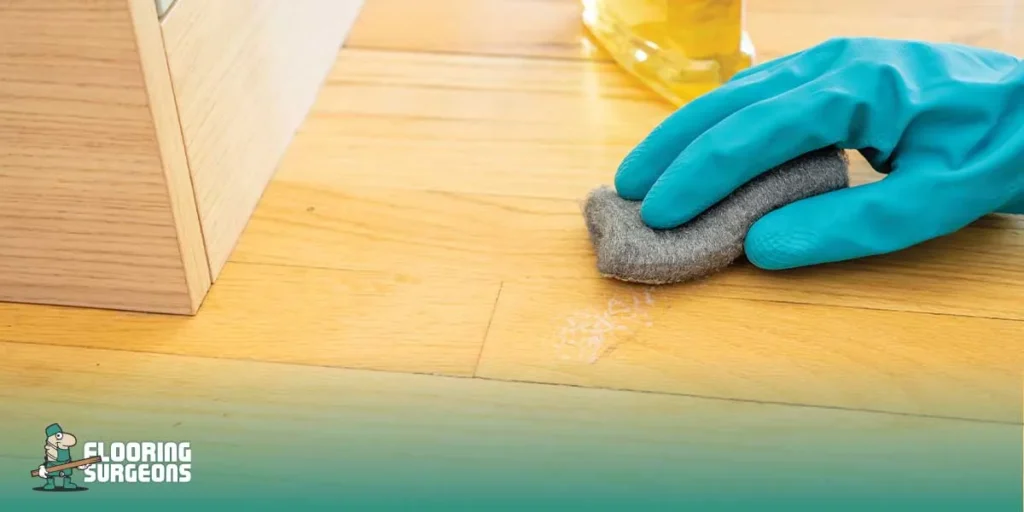
Why Cleaning Engineered Hardwood Floors Requires Special Care
At first glance, cleaning engineered hardwood may seem just like cleaning solid wood but beneath the surface, they’re very different. Solid hardwood is a single piece of timber that can be sanded and refinished multiple times, while engineered wood has a layered structure designed for stability. Its real wood veneer sits on plywood or fibreboard layers, making it more resistant to temperature and humidity changes yet more vulnerable to surface moisture.
When water seeps into engineered wood, it can get trapped between layers, weakening adhesives and causing warping or bubbling. To avoid this, always install a quality Underlay For Engineered Flooring, which acts as a moisture barrier and adds sound insulation, helping your floor stay stable and comfortable for years.
Cleaning should always be gentle: use a slightly damp microfiber mop and a pH-neutral wood cleaner. Skip steam mops, vinegar, and harsh detergents they can dull or damage the protective finish. Most engineered floors have a UV-cured lacquer or oil coating that isn’t easily refinished, so prevention is key.
In short, caring for engineered hardwood isn’t just about cleaning dirt; it’s about protecting its craftsmanship. With regular sweeping, quick spill clean-ups, and occasional polishing, you’ll preserve both its beauty and durability.
How to Clean Engineered Hardwood Floors Daily
aily cleaning is the simplest and most effective way to extend your floor’s life. Every day, dust and grit act like sandpaper underfoot the longer they sit, the faster they scratch the finish. Here’s how to prevent that:
- Sweep or vacuum once a day with a soft-bristle head. Avoid beater bars, as they can leave fine marks.
- Spot-clean spills immediately with a dry microfiber cloth or lightly damp paper towel never let liquid sit, even for a few minutes.
- Use doormats at all entrances to trap debris before it reaches your floor. A washable rug in high-traffic zones adds extra protection.
- Avoid over-cleaning don’t spray or mop every day unless absolutely needed; moisture exposure, even small amounts, adds up over time.
Pro Tip: A quick daily dust mop removes up to 80% of grime that could otherwise damage your finish it’s faster than mopping and far safer for engineered hardwood floors.
And remember, can you steam clean engineered wood floors? The answer is no. Steam cleaning can cause irreversible damage by introducing excessive moisture and heat that weakens the finish and the layers beneath.
For more tips on maintaining your floors, check out our guide on How to Clean Solid Wood Flooring and How to Clean Engineered Hardwood Floors Daily.

Weekly Cleaning Routine for Engineered Wood Flooring
Weekly maintenance keeps your floor fresh and glossy without stripping its finish. This is where you use light moisture, but always with control.
- Vacuum or dust thoroughly before applying any cleaner. Dirt trapped under the mop can act like sandpaper.
- Use a pH-neutral engineered floor cleaner diluted as directed. Spray it onto the mop, not the floor.
- Wipe with a flat microfiber mop, following the grain. Rinse and wring out often to avoid streaks.
- Dry immediately use a clean, dry cloth or towel to remove any remaining moisture.
- Inspect joints and edges for trapped water or dirt; wipe carefully if you notice damp spots.
Weekly cleaning is also a good time to inspect your floor’s condition dull areas or minor scratches might need spot treatment with a maintenance oil or polish (available in the Cleaning & Care Products section of Flooring Surgeons).
If you’re wondering how to clean engineered wood floors properly, following these steps ensures you maintain their beauty and durability without risking damage.
How to Deep Clean Engineered Wood Floors Safely
Even with great routine care, engineered wood floors need an occasional deep clean ideally every 3 to 6 months, depending on traffic. The goal is to lift embedded dirt without disturbing the protective finish.
- Clear the area completely move rugs and furniture to prevent uneven cleaning.
- Vacuum thoroughly, including skirting boards and corners.
- Apply a specialised deep cleaner formulated for engineered wood. These dissolve grime without harsh chemicals.
- Work section by section, applying cleaner with a damp (not wet) mop. Avoid letting moisture pool anywhere.
- Rinse the mop often, changing water when it becomes cloudy.
- Buff dry with a microfiber towel to restore the natural sheen.
Avoid the temptation to “power clean” with heavy scrubbing pads or vinegar-water mixes they may seem harmless, but can etch or haze the surface over time. Deep cleaning is about careful repetition, not aggression.
For the best way to clean engineered wood floors, follow these steps to ensure your floor stays beautiful and protected for years.
Can You Steam Clean Engineered Hardwood Floors?
In short — no, you should never steam clean engineered hardwood floors. The layers beneath the surface are bonded with heat-sensitive adhesives, and steam forces moisture into them, leading to swelling, delamination, or bubbling that can’t be repaired.
Instead, use a lightly damp mop with warm (not hot) water and a dedicated wood floor cleaner. For a refreshed look, buff the floor afterward with a dry microfiber pad to restore its natural shine safely.
Pro Tip: Even so-called “steam-safe” tools can void your warranty. Always follow your manufacturer’s care guide for example, Flooring Surgeons floors are made for low-moisture cleaning only.
How to Clean Oiled Engineered Wood Flooring the Right Way
Oiled engineered floors have a natural, matte charm but they need gentler cleaning than lacquered finishes. The oil protects the wood by soaking into it rather than sealing it entirely, meaning harsh chemicals or excessive water can strip away the oil and leave dull, dry patches.
- Dust or vacuum daily to keep grit off the surface.
- Use a soap-based wood cleaner made explicitly for oiled floors it cleans while replenishing small amounts of oil.
- Mop lightly, following the grain, and avoid oversaturating.
- Buff after drying to restore an even sheen.
- Re-oil every 6–12 months, or when you notice dullness or dry spots.
For long-term protection, use maintenance oils from trusted brands available through Flooring Surgeons they’re formulated to match the exact finish of your engineered wood.
How to Clean Engineered Oak Flooring and Preserve Its Finish
Engineered oak flooring is loved for its golden tones and timeless look but oak is more porous than other species, meaning it absorbs liquids quickly and shows scratches more easily. Keeping it clean is about protecting that delicate top veneer.
- Avoid vinegar and acidic cleaners, which react with the oak’s tannins and cause discolouration.
- Use a soft microfiber mop with lukewarm water and neutral cleaner no soaking.
- Wipe immediately after mopping to prevent moisture spots.
- Polish occasionally with a suitable oak maintenance oil or wax to maintain its rich colour.
- Avoid direct sunlight when possible UV rays can fade oak faster than those of darker woods.
Bonus Tip: Oak floors respond beautifully to regular, gentle buffing it enhances the grain and gives a natural glow without any added chemicals.
For oak-specific maintenance oils and cleaners, check the Engineered Wood Flooring Care Collection at Flooring Surgeons every product there is approved for delicate hardwood species like oak.
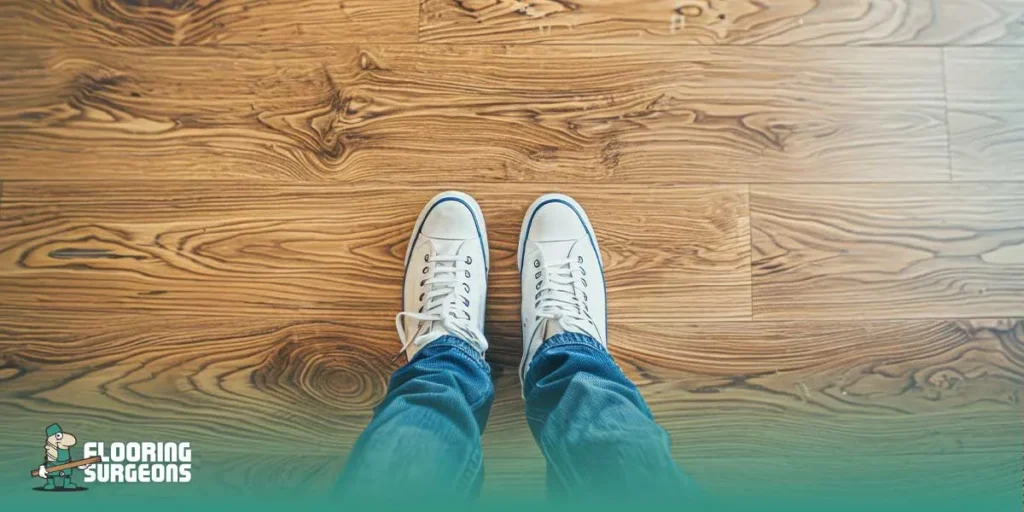
What to Use to Clean Engineered Wood Floors (Tools & Cleaners)
Choosing what to use to clean engineered wood floors is just as important as how you clean them. The wrong tools or chemicals can dull the finish, weaken the surface layer, or even damage the delicate bonding between layers. To keep your floor spotless and long-lasting, you need a gentle yet effective combination of the right cleaning tools and the right cleaner nothing more, nothing less.
The essentials every engineered wood owner should have include:
- Soft-bristle broom or vacuum with hardwood setting – Removes grit and dust without scratching.
- Microfiber mop (flat head, not string) – Ideal for light, damp cleaning; holds moisture evenly.
- Two-bucket system – One for clean water, one for rinsing; prevents re-spreading dirt.
- pH-neutral cleaner – Specifically formulated for wood floors to lift grime without damaging the finish.
- Microfiber towels or soft cloths – Perfect for drying and buffing to a streak-free shine.
Avoid abrasive brushes, steam mops, and all-purpose cleaners with strong solvents or acids. Remember your floor’s top layer is real wood, not plastic, so every product you use should protect that surface, not attack it.
If you’re unsure where to start, browse the Cleaning & Care Products Collection at Flooring Surgeons they carry trusted, wood-safe options suited to every finish type (lacquered, oiled, or brushed).
Recommended Cleaning Products for Engineered Hardwood Floors
When it comes to cleaning engineered hardwood floors, professional installers and homeowners alike agree: less is more. You don’t need a cupboard full of products just high-quality, residue-free cleaners explicitly designed for engineered wood.
Top recommended cleaner types:
- pH-neutral wood floor cleaners: These lift dirt and oils gently without stripping the finish.
- Soap-based natural cleaners (for oiled floors): Mild, nourishing formulas that replace lost oil during cleaning.
- Protective polishes and refreshers: Used once or twice a year to restore shine and reinforce the wear layer.
- Microfiber mop systems: Brands like Bona or Osmo offer reusable pads that trap dirt efficiently.
Expert Tip: Never use vinegar, dish soap, or “multi-surface” cleaners. While they seem harmless, they break down the protective coating on engineered hardwood, leaving a sticky or cloudy residue that attracts more dirt.
For a ready-to-use bundle of safe cleaners and maintenance accessories, explore the Flooring Surgeons Cleaning Range every product listed there is carefully tested for engineered flooring finishes. If you’re undertaking a repair or minor reinstallation, make sure to use a high-quality Flooring Adhesive specifically formulated for wood and engineered floors. The right adhesive not only enhances bond strength but also maintains flexibility, preventing cracking or lifting as your floor naturally expands and contracts with seasonal changes.
Using pH-Neutral Cleaners on Engineered Wooden Floors
The secret weapon for long-lasting engineered wood floors is the pH-neutral cleaner. Unlike acidic or alkaline formulas, pH-neutral products match the natural pH of your floor’s finish they remove grime without chemically reacting with the protective coating.
When cleaning an engineered wooden floor, always dilute the cleaner according to the label (usually a few caps per litre of water). Apply it directly to your mop, not the floor. This method prevents moisture from seeping into joints or cracks. Work in sections and dry immediately with a soft cloth or towel.
Benefits of pH-neutral cleaners:
- Maintain natural gloss without streaks.
- Prevent dulling, haze, or discolouration over time.
- Safe for all finishes oiled, lacquered, brushed, or UV-cured.
- Compatible with underfloor heating systems and sensitive adhesives.
If your floor has an oiled finish, alternate between a pH-neutral cleaner and an oil-replenishing soap every few months it restores surface elasticity and protects the wood from drying out.
At Flooring Surgeons, you’ll find pH-balanced cleaners formulated explicitly for engineered wood surfaces perfect for both routine and deep cleaning.
How to Remove Scratches and Stains from Engineered Wood Floors
Even the best-maintained floors face reality: furniture scuffs, pet claws, water spills, or dropped objects. The good news is that removing scratches from engineered wood floors doesn’t have to mean a full replacement most minor damage can be repaired with simple tools and the right approach.
Before you start, identify your floor’s finish: oiled, lacquered, or matt. Each responds differently to repair methods. Always clean the area first and test any product in a hidden corner.

How to Fix Minor Scratches on Engineered Hardwood Flooring
Minor surface scratches are normal especially in high-traffic zones but they’re also easy to fix if you act quickly.
- Clean the Area: Remove dust and debris using a soft, dry cloth.
- Apply Repair Wax or Touch-Up Pen: Use a colour-matched repair kit designed for engineered hardwood flooring. Gently fill or blend the scratch.
- Buff Smooth: Once dry, buff with a soft cloth to even out the sheen.
- Re-oil or Re-seal (if needed): For oiled finishes, apply a small amount of maintenance oil to restore protection.
For deeper scratches that reach the wood veneer, a professional sanding and refinishing may be required but remember, engineered floors can be sanded only a few times due to their thinner top layer.
Pro Tip: Keep a small repair kit handy. Flooring Surgeons offers colour-matched repair wax kits that blend perfectly with your floor tone and finish, so you’re always prepared for minor accidents.
How to Remove Water Stains from Engineered Wood Floors
Water stains are the most common (and most feared) issue with engineered flooring. They often appear as cloudy white patches or darker rings caused by moisture trapped beneath the finish.
Here’s how to tackle them safely:
- Blot Immediately: Never let standing water sit. Use paper towels or a dry microfiber cloth to soak it up.
- Mild Heat Treatment: Place a clean cloth over the stain and gently iron on low heat for a few seconds this draws moisture out from beneath the finish.
- White Vinegar Alternative (Caution): If heat doesn’t work, mix one part white vinegar with two parts olive oil. Dab lightly on the stain, let it rest for a few minutes, then wipe and buff dry.
- For Oiled Floors: Reapply a small amount of maintenance oil afterwards to seal the area.
- Severe Stains: For deep discolouration or swelling, contact a professional fitter replacing affected planks may be necessary.
Expert Advice: Always keep humidity balanced (40–60%) indoors. It’s the single best preventive measure against future watermarks, swelling, and gaps.
For approved stain removers and wood-safe maintenance oils, check the Engineered Flooring Repair & Care Range at Flooring Surgeons.
Polishing and Oiling Engineered Wood Floors Once a Year
Even with daily care, polishing engineered wood floors at least once a year is essential to maintain their protective finish, natural shine, and durability. Engineered wood has a real hardwood veneer that gradually loses its lustre from foot traffic, sunlight, and cleaning. Annual oiling or polishing restores the surface’s resilience, revives its tone, and seals microscopic scratches that accumulate over time.
Here’s how to do it properly:
- Deep Clean First: Start with a pH-neutral cleaner and a lightly damp microfiber mop to remove all dirt and residue. The surface must be spotless before applying oil or polish.
- Choose the Right Product: Use a polish or maintenance oil specifically designed for engineered wood floors never use wax or generic wood polishes meant for furniture.
- Apply evenly: For oiled floors, pour a small amount of maintenance oil on a soft cloth or applicator pad. Work it in thin, even layers following the wood grain. For lacquered finishes, use a non-slip polish and buff gently.
- Buff Thoroughly: After 20–30 minutes, buff the floor with a dry microfiber pad to remove excess product and create a uniform sheen.
- Let It Cure: Allow 6–12 hours before walking on the floor and 24 hours before replacing furniture.
Expert Tip: Regular polishing doesn’t just restore shine it reinforces the protective barrier that shields your floor from water, dirt, and UV damage. Done yearly, it can extend your floor’s lifespan by up to a decade.
You can find premium-grade oils and polishes for oiled engineered wood flooring including oak and walnut finishes in the Cleaning & Maintenance Range at Flooring Surgeons. Each product is approved for engineered surfaces and compatible with underfloor heating.
Best Oil and Polish for Engineered Oak or Oiled Wood Floors
When it comes to caring for oiled engineered wood flooring, not all maintenance products are created equal. The goal isn’t just to make your floor look shiny it’s to nourish the wood and strengthen its surface without leaving greasy residue or buildup.
Top recommended options:
- Hardwax Oils (Osmo, Blanchon, Bona): Ideal for oak floors; they penetrate deeply, enhance the natural grain, and create a protective micro-layer on top.
- Maintenance Oils: Used for periodic refreshes between full re-oiling sessions to restore smoothness and tone.
- Non-Slip Polishes: For lacquered or satin finishes, these create a refined glow and protect from minor scuffs.
- Tinted Oils: Perfect for refreshing or slightly altering oak tones (e.g., honey, whitewash, or smoked effects).
Application Tips:
- Always test oil on a small corner first wood species and finishes react differently.
- Apply with a lint-free cloth or buffing pad, not a mop.
- For extra durability, use a mechanical floor polisher in large rooms it evenly distributes the oil.
Pro Tip: Engineered oak floors benefit from re-oiling every 12–18 months, especially in high-traffic zones. For premium results, use products designed for UV-oiled or brushed oak surfaces available via Flooring Surgeons’ Cleaning and Care Accessories.

What Not to Do When Cleaning Engineered Hardwood Floors
Knowing what not to do is just as important as knowing the best cleaning methods. Many everyday household cleaning habits even ones that seem harmless can shorten the life of your engineered flooring. Here’s a clear list of mistakes to avoid to keep your floor pristine.
Why You Shouldn’t Use Vinegar to Clean Engineered Wood Floors
Many DIY guides claim vinegar is a natural, safe cleaner for wood floors but for engineered wood, it’s a hidden danger. Vinegar’s acidity gradually erodes the protective finish, leading to dullness, streaks, and micro-damage in the lacquer or oil layer. Over time, this weakens your floor’s resistance to moisture and causes irreversible wear.
For an eco-friendly alternative, use pH-neutral, plant-based wood cleaners that deliver the same cleaning power without the harsh effects. Flooring Surgeons offers sustainable, residue-free formulas safe for all engineered surfaces.
Pro Tip: One vinegar cleaning might seem harmless, but repeated use can cut your floor’s lifespan in half. Think of vinegar as liquid sandpaper for engineered finishes.
Common Mistakes That Damage Engineered Wood Flooring
Even with the best intentions, minor cleaning errors can slowly ruin the beauty of engineered wood flooring. Below are the top mistakes homeowners make and how to avoid them.
- Using Too Much Water: Excess moisture seeps between planks, causing warping or lifting. Always use a damp, not wet, mop.
- Steam Cleaning: The combination of high heat and moisture weakens adhesives, leading to bubbling or delamination.
- Harsh Chemicals or Ammonia: They erode protective coatings and strip natural oils from the wood surface.
- Skipping Regular Dusting: Grit and dust act like sandpaper underfoot, scratching the surface layer over time.
- Using Wax or Furniture Polish: These leave a slippery residue that attracts dust and creates buildup, dulling the finish.
- Dragging Furniture: Always lift, never slide or use felt pads under all furniture legs.
- Ignoring Humidity Levels: Extreme dry or damp conditions cause expansion gaps or shrinkage. Aim for 40–60% indoor humidity.
- Neglecting Entry Mats: Without mats, dirt and moisture from shoes grind directly into the surface.
Bonus Tip: If your engineered wood floor starts to lose its glow despite careful cleaning, it’s probably not dirty it just needs a maintenance polish or re-oil.
When to Call a Professional for Engineered Wood Floor Maintenance
Even with regular care, every floor eventually needs a professional touch. Engineered wood floor maintenance goes beyond daily cleaning it’s about preserving structure, restoring finish, and protecting your investment long-term.
You should call a professional when:
- Scratches or dents reach the wood veneer: DIY repair kits only fix surface marks. Deep scratches require sanding and refinishing something that must be done carefully to avoid wearing through the top layer.
- Large water stains or swelling appear: Professionals can determine if planks can be saved or need replacing before damage spreads.
- The finish looks patchy or uneven: When polishing or re-oiling no longer restores shine evenly, the finish has likely worn thin. Professionals can deep-clean, buff, and recoat to renew protection.
- Floorboards are lifting or squeaking: These are signs of subfloor or adhesive issues that need expert diagnosis, not more cleaning.
- It’s been 3–5 years since the last complete maintenance: Even the most durable engineered floors benefit from professional deep cleaning and resealing every few years especially in high-traffic areas.
Pro Insight: Think of professional floor maintenance like a service check for your car even if everything looks fine, preventive care keeps it performing beautifully for decades.
At Flooring Surgeons, you can request tailored maintenance advice or connect with certified installers who know exactly how to refinish or restore engineered floors without damaging the veneer.
Professional Cleaning vs DIY: What’s Best for Engineered Hardwood Floors?
When it comes to professional cleaning for engineered hardwood floors, the right choice depends on the floor’s condition and your confidence level. Here’s a breakdown to help you decide:
| Scenario | DIY Cleaning | Professional Cleaning |
| Light dust, daily care | Perfectly manageable with pH-neutral cleaners and microfiber mops. | Not necessary. |
| Minor scuffs or dullness | Try polish or maintenance oil; small scratches can be buffed. | Professionals can help if the finish appears uneven. |
| Deep stains or discolouration | Possible with gentle techniques, but risky for amateurs. | Experts use machine buffing and specialised solutions safely. |
| Floor swelling or lifting | Avoid DIY — moisture or structural damage may worsen. | Professionals assess and repair underlying causes. |
| Annual re-oiling or resealing | Possible for experienced DIYers with proper tools. | Recommended for uniform results and lasting protection. |
DIY cleaning works for everyday care sweeping, light mopping, polishing. But professional cleaning becomes essential once surface wear, dullness, or moisture damage appears. Professionals use low-moisture extraction systems and specialised polishers that restore depth without removing too much of the finish.
Expert Tip: Mixing DIY upkeep with professional servicing every 2–3 years is the ideal balance. It saves money in the long term while keeping your engineered hardwood floors in showroom condition.
Best Techniques to Clean Engineered Wood Floors
Cleaning engineered wood floors the right way is all about balance enough cleaning to preserve beauty, not enough to harm the finish. Here’s a fast recap of the best techniques to clean engineered wood floors and keep them shining for years:
- Daily: Dust or vacuum with a soft-bristle head to remove grit and prevent microscratches.
- Weekly: Use a pH-neutral cleaner with a damp (not wet) microfiber mop. Always clean along the grain.
- Monthly: Inspect for scratches, dull patches, or stains. Spot-treat with repair kits or maintenance oil.
- Every 6–12 months: Deep-clean with a professional-grade wood floor cleaner or have a maintenance oil applied.
- Yearly: Polish or re-oil the surface to rejuvenate the finish and seal out moisture.
- Never: Use steam mops, vinegar, or abrasive tools. They strip the finish and weaken the structure.
Final Tip: Prevention is always easier (and cheaper) than restoration. Simple habits can make a major difference in maintaining your floor’s condition. Use entry mats to capture dirt and grit before it scratches the surface, attach felt pads under furniture legs to prevent dents, and maintain consistent indoor humidity (around 40–60%) to keep your engineered wood stable throughout the year.
If your home includes solid timber sections, you might also want to review our detailed guide on How to Clean Solid Wood Flooring to ensure both types of surfaces stay in perfect condition.
Shop Cleaning & Care Products for Engineered Wood Floors at Flooring Surgeons
When it comes to maintaining engineered floors, the right products make all the difference. Flooring Surgeons offers a complete range of cleaning and care products formulated specifically for engineered wood surfaces everything from pH-neutral cleaners and oiled-floor soaps to polishing kits and maintenance oils.
Whether your floor is lacquered, brushed, or oiled, using professional-grade products ensures long-term protection and natural beauty.






